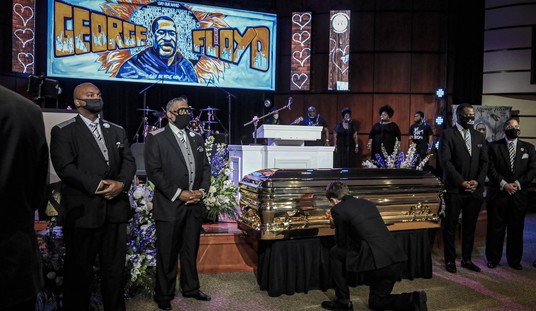
In this grab taken from footage provided by the Russian State Atomic Energy Corporation ROSATOM press service, people gather for the funerals of five Russian nuclear engineers killed by a rocket explosion in Sarov, the closed city, located 370 kilometers (230 miles) east of Moscow, Monday, Aug. 12, 2019. Thousands of people have attended the burial of five Russian nuclear engineers killed by an explosion during tests of a new rocket. The engineers, who died on Thursday, were laid to rest Monday in the city of Sarov that hosts Russia’s main nuclear weapons research center. (Russian State Atomic Energy Corporation ROSATOM via AP)
A week ago, Russia suffered what submariners might call a “nuclear casualty” in the isolated military weapons testing facility near
Russian media speculates that Severodvinsk explosion happened during tests of Tsirkon hypersonic cruise missile near Nyonoksa—a test site for rocket-powered ballistic missiles. Authorities acknowledged an increase in ambient radiation after the accident.https://t.co/f0BcitZYzC
— Julia Davis (@JuliaDavisNews) August 8, 2019
I covered that in this post…a post which caused damp panties in some circle because of the image I used, but screw ’em if they can’t take a joke.
Now, as the details gradually filter out we aren’t left with a warm fuzzy feeling that the scope and nature of the nuclear event has been adequately explained.
The suspicion is that this explosion is linked to the alleged nuclear cruise missile Vladimir Putin woofed about back in March:
The Burevestnik (“Storm Petrel”) is designed to evade U.S. defenses, flying for hours or even days to exploit holes in missile defense networks that most weapons can’t reach. Russia hadn’t tested the weapon in nearly a year—until last week, that is.
According to The Diplomat, the test took place on January 29 at Kapustin Yar, one of Russia’s major weapon-testing grounds. The website quoted anonymous sources in the U.S. government with knowledge of the weapons program. The missile is known to the U.S. intelligence community as the KY30, or the SSC-X-9 “Skyfall.”
In November 2017, a “moderately successful” test of Skyfall from the Pan’kovo test site on the Arctic island of Novaya Zemlya resulted in several Russian ships fishing debris and nuclear materials from the Barents Sea. The Diplomat’s sources describe the most recent test as “partially successful.”
Russian President Vladimir Putin officially announced this weapon’s existence back in March 2018. Putin stated, “The launch and the set of ground tests allow [Russia] to get to creating a radically new type of weaponry—a strategic nuclear weaponry complex with a missile fitted with a nuclear powered engine.” Putin further described the missile, later named Burevestnik via a poll of the Russian public, as having “unlimited range and unlimited ability to maneuver.”
Just to digress a brief moment, this has always struck me as much more of a PR gimmick, the weapons industry equivalent of vaporware, that a real thing. The idea is that you create a ramjet engine that is somehow fueled by a nuclear reactor. A conventional rocket motor gets the missile up to minimum operating speed and the reactor, presumably, heats the incoming air to flashpoint without the use of fuel injection. Of course, the problems posed by the reactor of shielding and of the radioactive waste left in its wake as air is ignited by contact with a nuclear source would seem to make it a suboptimal system. There are a lot of questions about its usefulness as well as its engineering. If, for instance, one of these devices was fired at, say, a US installation, would we consider it a conventional or nuclear attack because the detonation is going to scatter fissile material if it doesn’t generate a real, if inefficient, nuclear blast. Where does this fit in to your defense strategy beyond making arms control weenies incontinent? What is the real need for a swarm of nuclear-powered cruise missiles? How do you store them?
What we know is that at least five Russian nuclear weapons scientists or engineers and two other people were killed in the explosion.
At memorial events in Sarov that included a gun salute, Rosatom head Alexei Likhachev praised the deceased nuclear experts as the “pride of the country” and the “pride of the atomic sector”.
“The best tribute to them will be our continued work on new models of weapons, which will definitely be carried out to the end,” Likhachev was quoted as saying by RIA news agency.
In a video interview published late on Sunday, an official at the scientists’ research institute in Sarov did not spell out exactly what they had been doing, but suggested that they had been working on a small nuclear reactor.
The official, Vyacheslav Solovyev, said the institute was working on “sources of thermal or electric energy using radioactive materials, including fissile materials and radioisotope materials”.
There are mixed stories about evacuation:
Residents of a Russian village near the site of a nuclear accident that killed seven people in Russia’s far north last week were left confused on Tuesday by conflicting reports that they would be evacuated while work is carried out on the site. Several unidentified residents of Nynoksa, in Russia’s Arkhangelsk region, told local news website 29.ru that they had been told they would have to leave the village for at least two hours, between 5 and 7 a.m. on Wednesday, and that a train would be provided for them.
The government of Severodvinsk, a city 25 miles away from Nynoksa, seemed to confirm the evacuation ordered to the state-run Interfax news agency.
“We have received a notification… about the planned activities of the military authorities. In this regard, residents of Nynoksa were asked to leave the territory of the village from August 14,” officials were quoted by Interfax as saying.
However, the governor of the Arkhangelsk region, Igor Orlov, dismissed that report in a separate interview with Interfax as “complete nonsense,” saying “no evacuation (is taking place).”
The Washington Post offers this:
The website reported that military officials had met with the villagers Monday to tell them they’d have to leave.
“They said that there were no changes in the radiation background and there was nothing to worry about,” said the resident, who asked not to be identified. “And that everything is fine both in our village and there, in the military town. The situation is checked by experts.”
But we know that the part about background radiation isn’t true because a spike in background radiation to 16 times the normal level has been independently confirmed.
The bottom line is we really don’t know what happened there beyond a massive explosion, a spike in background radiation, an evacuation of civilians that may or may not have taken place, and nearly two dozed acknowledged casualties. The fact that it happened at a classified test range and the Russians had to admit this much hints that the actual scope is much worse.














Join the conversation as a VIP Member